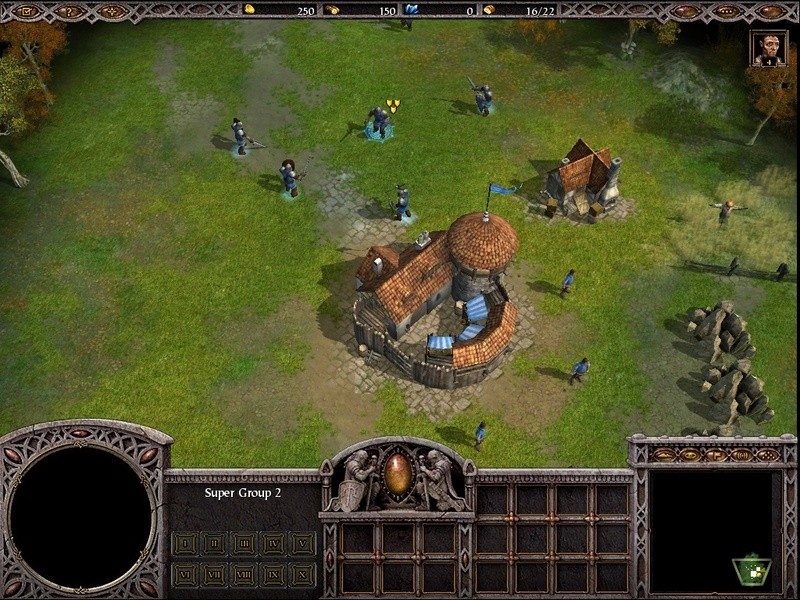
This is just another small thing, but all of the small things begin to detract from a polished product, and a truly good game. What this means is that when I tell a unit to attack, while he “hitting” the opponent, it does not appear as though he is actually striking at his enemy, merely coming close to hitting. The other units sometimes seem to have a force field around them.

Games like this leave a lot to be desired. Only a few games, such as Rise of Nations, has improved the graphics in the strategy games. The year is almost 2005, and computers are running at unbelievable speeds and rates, and you’d expect the graphics of these real-time strategy games to increase, but they simply have not. The graphics in Armies of Exigo are pretty basic. There are four multiplayer types: Melee, King of the Hill, Capture the Flag, and Skirmish. So this is where Armies of Exigo decides to throw the multiplayer portion of the game at you. They also seem to be a little bit scripted, so you are likely to see the same thing each time you play through, basically eliminating the replay ability, unless you up the difficulty level. The missions are linear, and quite simple in terms of how they are played out. Protect this city, move here, attack, and produce more units. Armies of Exigo plays like any other strategy game. Yes, that does sound like nit-picking, but it is just something you feel like you have to have. So you see the action, with absolutely no sound to it, and I was a bit disappointed in that, after all every real-time strategy game I’ve played like this one before, I have been able to hear that small detail. Tell your peasants to mine for gold, and you cannot hear them knocking away at the rocks. Armies of Exigo attempts to combine many elements from other games on the market, but it just seemingly comes up short in so many areas. It does not have all of the pizzazz as some of the other RTS out there, but it is in a class of its own in terms of what it is trying to do. Now attacks can come from out of nowhere, unlike other games where you can see when they are coming, and from what direction. I’ll agree to a certain extent this new idea in the world of real-time strategy games does add a little bit of strategy to the game. The ability to fight underground had me mesmerized for about two minutes, until I realized it’s nothing different than fighting above ground, only somehow it supposedly changes my strategy. The interface is like anything you’d expect, and the biggest thing Armies of Exigo claims to innovate is the ability to fight underground. The game plays just like any other RTS on the market. The game really has nothing innovative in terms of RTS goes. Point click, point click, a simple feature.

The controls of the game are just like any other RTS out there on the market. Not sure if I would call that exactly massive. You can control “massive” armies according to EA, but this is limited to just 200 units. In Armies of Exigo you’ll control an Army, like any other RTS. Sure Armies of Exigo, published by Electronic Arts, sounds like an interesting game, but does it live up to more than just the nice words? A sinister force known as The Fallen have awaken to strike where the inhabitants of this world least expect - from underground. The setup of Armies of Exigo is this In the world of Exigo, where peace and prosperity have reigned for years, the empires of man and beast face their greatest threat yet. The game now has war waged both above and below the ground. The 5th-century Saxon invaders were followed by the Danes, who won the Battle of Maldon in 991.Armies of Exigo is a game that has entered the realms of fantasy RTS. They simply got off their horses (for the most part) when it came to the important matter of sword play. The Anglo-Saxon army looked like a cavalry force. Yet, the Anglo-Saxons seem to have not used cavalry often in warfare, putting them at a sharp disadvantage to the Normans. Were Anglo-Saxons warriors? Why didn’t the Anglo-Saxons have cavalry?Įngland is perfectly suited to raising horses, and the Anglo-Saxons did raise them, and they aren’t like their cousins – the Vikings – who didn’t use cavalry often since they attacked from the sea. The two largest were the Angle and Saxon, which is how we’ve come to know them as the Anglo-Saxons today.

Made up of three tribes who came over from Europe, they were called the Angle, Saxon, and Jute tribes. The Anglo-Saxons were a group of farmer-warriors who lived in Britain over a thousand years ago.

At the battle of Ashdown in 871, Alfred routed the Viking army in a fiercely fought uphill assault. Who was the commander of the Anglo-Saxon army?įinally, in 870 the Danes attacked the only remaining independent Anglo-Saxon kingdom, Wessex, whose forces were commanded by King Aethelred and his younger brother Alfred.


 0 kommentar(er)
0 kommentar(er)
